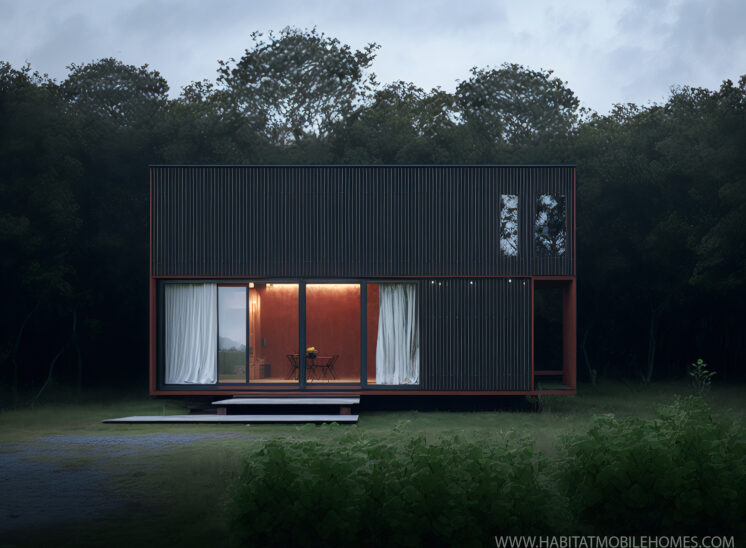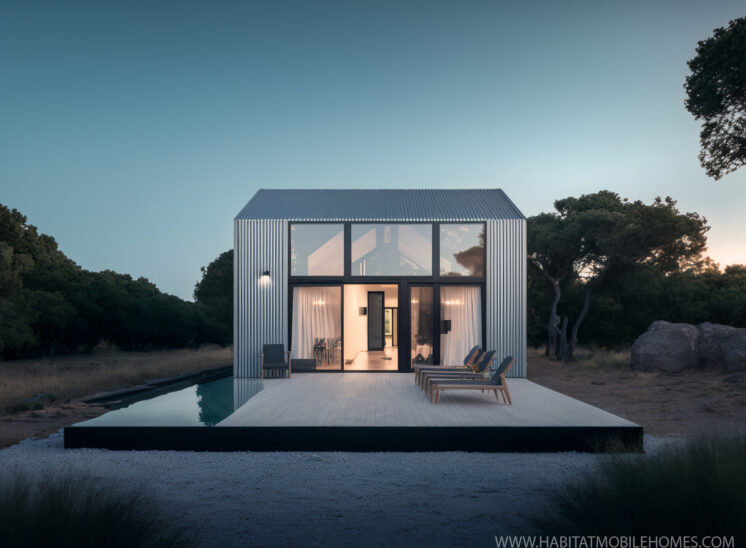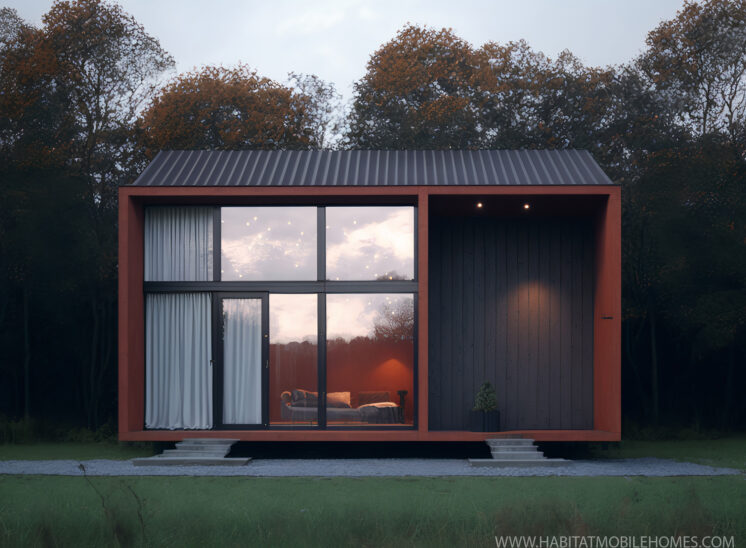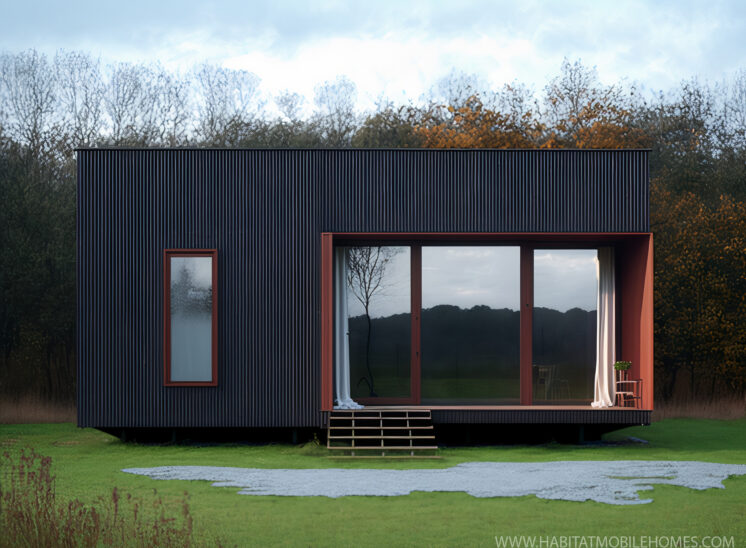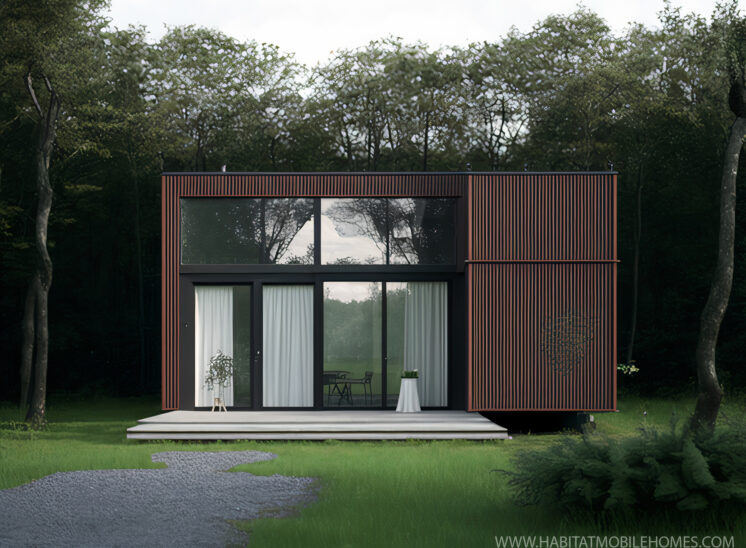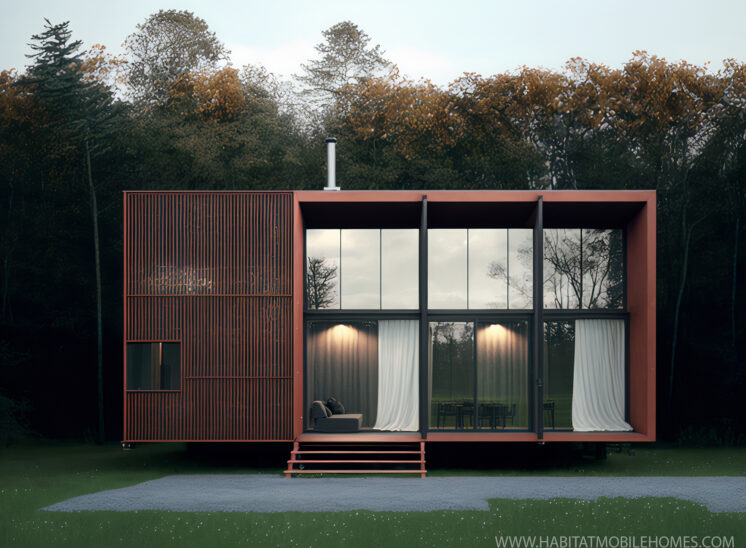RedBarnConversion: A Modern Twist on Rural Homes
Have you ever wanted to experience the peace and tranquility of rural life without sacrificing modern comforts? Now, you can with RedBarnConversion’s new range of twin unit mobile homes and timber frame buildings. With its sleek design, vertical thin profile cladding, and slats in black and red, this modern conversion of barns is sure to turn heads. Let’s take a closer look at what makes this style of rural living so special. RedBarnConversion’s twin units are designed to give you the best of both worlds—the rustic charm of a barn combined with all the modern amenities that come with high-end living. The exterior features vertical thin profile cladding and slats in black and red for a unique look that stands out from traditional wood siding or brick walls. Inside, the rooms are spacious yet cozy, featuring large windows that let in natural light as well as views of the surrounding countryside.
These homes offer more than just great looks—they also boast superior functionality. RedBarnConversion units are equipped with all the necessary amenities for comfortable living, including heating and cooling systems, water heaters, kitchens, bathrooms, bedrooms, landline telephone connections, television access points, internet connections (wired/wireless), etc. The interior has been designed to maximize space while still allowing plenty of room for storage. Plus, these homes also come with solar panels so you can enjoy energy savings every month!
Understanding Planning Permission for Barn Conversions in the UK
Barn conversions have become increasingly popular in the UK in recent years, providing a unique and characterful living space for homeowners. However, if you are considering converting a barn, one of the first questions you may ask is whether planning permission is required.
The good news is that if your barn is located on agricultural land, you may be able to take advantage of permitted development rights, which allow you to carry out certain works without the need for planning permission. If your farm is 5 hectares or more, you have the right to erect, extend, or alter a building, as well as carry out excavations and engineering operations needed for agricultural purposes.
However, it's important to note that there are certain limitations to these rights. For instance, any work must not exceed a certain size, and there may be restrictions on the type of materials that can be used. It's always best to check with your local planning authority to confirm the specifics of what you can and cannot do without planning permission.
If your proposed conversion does not fall under permitted development rights, you will need to apply for planning permission. This is where things can get a bit more complicated, as there are various factors that will be taken into account by the planning authority when considering your application.
One of the key considerations will be the impact of the conversion on the surrounding area. This will include factors such as noise, traffic, and the visual impact of the building. If your proposed conversion is in a particularly sensitive location, such as a conservation area or an Area of Outstanding Natural Beauty, you may face additional restrictions or requirements.
Another important consideration is the design and appearance of the converted barn. The planning authority will be looking to ensure that the conversion is sympathetic to the original building and surrounding area, and may require detailed plans and drawings to be submitted as part of the planning application.
Overall, while the process of obtaining planning permission for a barn conversion can be complex and time-consuming, it is important to ensure that all necessary permissions are obtained before beginning any work. Failure to do so can result in enforcement action being taken, which can be costly and time-consuming to rectify. However, with careful planning and consideration, a barn conversion can provide a unique and characterful living space that is both practical and aesthetically pleasing.
Class Q Barn Conversion: Understanding the UK Planning Law
The UK government introduced Class Q barn conversion in 2014, which allows farmers and landowners to convert their agricultural buildings into residential homes without the need for planning permission. This policy was introduced to help address the shortage of housing in rural areas, while also promoting the re-use of existing buildings.
What is Class Q?
Class Q is a permitted development right that allows for the conversion of agricultural buildings into residential homes without the need for planning permission. The conversion must comply with certain criteria to be eligible for Class Q. These criteria are outlined below:
The building must have been solely used for agricultural purposes on or before 20 March 2013.
The building must be structurally sound and capable of being converted into a residential dwelling.
The total floor area of the building being converted must not exceed 465 square metres.
The building must not be listed or located within a designated area, such as a conservation area or an Area of Outstanding Natural Beauty (AONB).
The conversion must include only the building itself and any associated land necessary for residential use.
The conversion must be completed within three years of the start of the development.
What are the benefits of Class Q?
Class Q barn conversion provides numerous benefits for farmers and landowners who wish to convert their agricultural buildings into residential homes. These benefits include:
Cost-effective conversion: Class Q barn conversion provides a cost-effective way to convert an existing agricultural building into a residential home without the need for planning permission.
Increased property value: By converting an agricultural building into a residential home, property owners can increase the value of their property and generate income from renting or selling the property.
Environmental benefits: By reusing existing buildings, Class Q barn conversion helps to reduce waste and limit the environmental impact of new builds.
Supporting rural communities: Class Q barn conversion helps to support rural communities by providing much-needed housing in rural areas, which can help to retain and attract families and workers.
In conclusion, Class Q barn conversion offers farmers and landowners the opportunity to convert their agricultural buildings into residential homes without the need for planning permission. This policy helps to address the shortage of housing in rural areas, while also promoting the re-use of existing buildings and supporting rural communities. However, it is important to ensure that your project complies with the eligibility criteria for Class Q before starting any conversion work.
Understanding Class Q Conversion Permission for Agricultural Buildings in the UK
If you own an agricultural building in the UK, you may be wondering if you can convert it into a residential property. The good news is that it is possible thanks to Class Q Conversion Permission. Introduced in 2014 as part of permitted development rights, Class Q allows for the conversion of agricultural buildings to residential properties without the need for a full planning application.
However, it's important to note that not all agricultural buildings will automatically qualify for Class Q Conversion Permission. The building must first meet certain criteria, including being in agricultural use on or before 20 March 2013, and not have been used for anything other than agriculture since that time. The building must also be structurally sound, and the proposed residential use must comply with various requirements, such as minimum floor area and outdoor space.
To apply for Class Q Conversion Permission, you will need to submit a 'prior approval' application to your local planning authority. The application will need to include various details such as proposed plans, site location, and any environmental impact assessments. The local planning authority will then have up to 56 days to decide whether to grant or refuse the prior approval.
It's important to note that while Class Q Conversion Permission can make the process of converting an agricultural building to residential use easier and faster, it's not a guaranteed approval. Some local planning authorities may refuse prior approval if they deem the proposal to not meet certain requirements, such as the impact on the local area or concerns around access to the site.
In conclusion, if you're interested in converting an agricultural building to a residential property, Class Q Conversion Permission can be a useful tool. However, it's important to carefully consider whether your building meets the necessary criteria and to thoroughly prepare your prior approval application to increase your chances of success.
Understanding Class Q Agricultural Building Conversion and Agricultural Tenancy Matters
Class Q refers to the permitted development right that allows for the conversion of existing agricultural buildings into residential properties without having to go through the full planning application process. Introduced in 2014, Class Q has become a popular route for farmers and landowners to repurpose their unused or redundant agricultural buildings into homes.
However, it's important to note that there are certain restrictions and regulations that need to be followed when it comes to Class Q conversions. One of the key considerations is the impact on agricultural tenancy matters.
Under Class Q, an existing agricultural tenant cannot terminate their tenancy in order to convert a building. This provision ensures that the landlord retains control over the use of the land and that agricultural activities can continue uninterrupted.
Furthermore, if the agricultural building in question is subject to an existing agricultural tenancy, then the landlord must seek written consent from the tenant before proceeding with the conversion. This is to ensure that the tenant is aware of any changes that may affect their tenancy agreement.
Additionally, there are certain criteria that need to be met in order for a building to be eligible for Class Q conversion. These include:
The building must have been in agricultural use on or before 20th March 2013.
The building must be structurally sound.
The maximum floor space for the residential conversion is 465 square meters.
The building must not be in an Area of Outstanding Natural Beauty, a National Park, a Site of Special Scientific Interest, or a listed building.
The converted dwelling must be used as a primary residence and not for holiday or second home purposes.
It's also worth noting that some local authorities may impose additional requirements or conditions on Class Q conversions in their area. Therefore, it's important to check with your local planning authority before proceeding with any conversion plans.
In conclusion, while Class Q agricultural building conversion offers a valuable opportunity to repurpose unused or redundant agricultural buildings, it's important to be aware of the regulations and restrictions involved, especially with regards to agricultural tenancy matters. By adhering to these guidelines, farmers and landowners can ensure a smooth and successful conversion process while also maintaining the integrity of their agricultural operations.
Understanding UK Law: Do Stables Qualify as Agricultural Buildings?
Stables are commonly associated with agriculture, but whether they are considered agricultural buildings under UK law can be a bit tricky to determine. The answer largely depends on the intended use of the stables and the activities taking place on the land where they are located.
In general, agricultural buildings are defined as structures that are used for the purposes of agriculture, including the breeding, keeping, rearing, and training of animals for agricultural use. This can include livestock such as cows and sheep, as well as crops and other plants.
When it comes to stables, the answer is not always clear cut. If the stables are used solely for the purpose of breeding, keeping, or training horses or other animals for agricultural purposes, then they may be considered agricultural buildings and may fall under permitted development rights for agricultural use.
However, if the stables are being used for activities such as equestrian sports, recreation, or business purposes, then they may not be considered agricultural buildings and may require planning permission.
It's important to note that even if stables are considered agricultural buildings, they may still be subject to certain regulations and restrictions. For example, there may be restrictions on the number of animals that can be kept on the property, or on the type of activities that can be conducted on the land.
Ultimately, whether or not stables are considered agricultural buildings will depend on the specific circumstances of each case. If you are unsure about whether your stables fall under permitted development rights or require planning permission, it's best to consult with a qualified planning professional or local authority for guidance.
In summary, while stables are often associated with agriculture, they may not always qualify as agricultural buildings under UK law. It's important to understand the intended use of the stables and the activities taking place on the land in order to determine whether or not planning permission is required.

